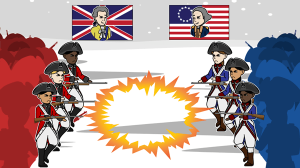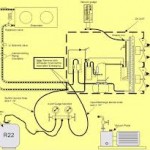American Revolutionary War – The American Revolution
American Revolutionary War – The American Revolution
The American Revolutionary War, often simply referred to as the American Revolution, was a pivotal conflict that took place between 1775 and 1783. It marked the birth of the United States of America and the end of British colonial rule in North America. Here are some key points about the American Revolutionary War:
Causes:
- Taxation without Representation: One of the primary causes of the American Revolution was the resentment of American colonists toward British taxation policies. The phrase “No taxation without representation” became a rallying cry, as colonists objected to being taxed by the British government without having a say in it.
- Conflict over Rights: The American colonists believed they were entitled to the same rights as British citizens, including the right to govern themselves. However, tensions increased as British authorities sought to assert more control over the colonies.
- Boston Massacre and Boston Tea Party: These events in the 1770s further heightened tensions. The Boston Massacre (1770) involved British soldiers firing on a crowd of colonists, and the Boston Tea Party (1773) saw colonists dumping British tea into Boston Harbor in protest of the Tea Act.
Major Events:
- Battles of Lexington and Concord (1775): These were the first military engagements of the war, resulting in skirmishes between colonial militias and British troops.
- Declaration of Independence (1776): On July 4, 1776, the Continental Congress adopted the Declaration of Independence, drafted primarily by Thomas Jefferson. This document proclaimed the colonies’ independence from British rule.
- Saratoga and Alliance with France (1777): The American victory at the Battle of Saratoga was a turning point in the war. It led to France formally entering the war as an ally of the American colonies.
- Yorktown (1781): The Battle of Yorktown was the decisive engagement of the war, resulting in the surrender of British forces under General Cornwallis to American and French forces.
Treaty of Paris (1783): The war officially ended with the signing of the Treaty of Paris in 1783. This treaty recognized the independence of the United States and established the boundaries between the new nation and British North America.
Impact:
- Birth of the United States: The American Revolutionary War resulted in the creation of the United States of America, a new nation that broke free from British colonial rule.
- Influence on Other Revolutions: The American Revolution served as an inspiration for other independence movements and revolutions around the world.
- Development of Constitutional Government: The Revolutionary period saw the drafting of the U.S. Constitution (1787) and the Bill of Rights (1791), laying the foundation for the American system of government.
- End of Colonialism: The American Revolution contributed to the decline of British colonialism and the eventual dissolution of other European colonial empires.
The American Revolutionary War was a complex and transformative event that shaped the course of history. It established the principles of democracy, self-determination, and individual rights that continue to influence political movements and nations worldwide.

American Revolutionary War – The American Revolution
- Allison, David, and Larrie D. Ferreiro, eds. The American Revolution: A World War (Smithsonian, 2018) excerpt
- Bobrick, Benson. Angel in the Whirlwind: The Triumph of the American Revolution. Penguin, 1998 (paperback reprint)
- British Army (1916) [7 August 1781]. Proceedings of a Board of general officers of the British army at New York, 1781. New-York Historical Society. Collections. The John Watts de Peyster publication fund series, no. 49. New York Historical Society. The board of inquiry was convened by Sir Henry Clinton into Army accounts and expenditures
- Caughey, John W. (1998). Bernardo de Gálvez in Louisiana 1776–1783. Gretna: Pelican Publishing Company. ISBN 978-1565545175.
- Chartrand, Rene. The French Army in the American War of Independence (1994). Short (48pp), very well illustrated descriptions.
- Christie, Ian R.; Labaree, Benjamin W. (1976). Empire or independence, 1760–1776. Phaidon Press. ISBN 978-0714816142.
- Commager, Henry Steele and Richard B. Morris, eds. The Spirit of ‘Seventy-Six’: The Story of the American Revolution as told by Participants. (Indianapolis: Bobbs-Merrill, 1958). online
- Conway, Stephen. The War of American Independence 1775–1783. Publisher: E. Arnold, 1995. ISBN 0340625201. 280 pp.
- Creigh, Alfred (1871). History of Washington County. B. Singerly. p. 49. ann hupp indian.
- Cook, Fred J. (1959). What Manner of Men. William Morrow and Co. 59-11702. Allan McLane, Chapter VIII, pp. 275–304
- Davies, Wallace Evan (July 1939). “Privateering around Long Island during the Revolution”. New York History. Fenimore Art Museum. 20 (3): 283–294. JSTOR 23134696.
- Duncan, Francis (1879). History of the Royal Regiment of Artillery. London: John Murray.
- Fleming, Thomas (1970). The Perils of Peace. New York: The Dial Press. ISBN 978-0061139116.
- Foner, Eric, “Whose Revolution?: The history of the United States’ founding from below” (review of Woody Holton, Liberty Is Sweet: The Hidden History of the American Revolution, Simon & Schuster, 2021, 800 pp.), The Nation, vol. 314, no. 8 (18–25 April 2022), pp. 32–37. Highlighted are the struggles and tragic fates of America’s Indians and Black slaves. For example, “In 1779 [George] Washington dispatched a contingent of soldiers to upstate New York to burn Indian towns and crops and seize hostages ‘of every age and sex.’ The following year, while serving as governor of Virginia, [Thomas] Jefferson ordered troops under the command of George Rogers Clark to enter the Ohio Valley and bring about the expulsion or ‘extermination’ of local Indians.” (pp. 34–35.)
- Fortescue, John (1902). A history of the British army. Vol. 3.
- Fremont-Barnes, Gregory; Ryerson, Richard A, eds. (2006). Encyclopedia of the American Revolutionary War: A Political, Social, and Military History. ABC-CLIO. ISBN 978-1851094080.
- Frey, Sylvia R (1982). The British Soldier in America: A Social History of Military Life in the Revolutionary Period. University of Texas Press. ISBN 978-0292780408.
- Grant, John N. (1973). “Black Immigrants into Nova Scotia, 1776–1815”. The Journal of Negro History. 58 (3): 253–270. doi:10.2307/2716777. JSTOR 2716777. S2CID 150064269.
- Jensen, Merrill (2004). The Founding of a Nation: A History of the American Revolution 1763–1776. Hackett Publishing. ISBN 978-0872207059.
- Hagist, Don N. (Winter 2011). “Unpublished Writings of Roger Lamb, Soldier of the American War of Independence”. Journal of the Society for Army Historical Research. Society for Army Historical Research. 89 (360): 280–290. JSTOR 44232931.
- Kaplan, Rodger (January 1990). “The Hidden War: British Intelligence Operations during the American Revolution”. The William and Mary Quarterly. Omohundro Institute of Early American History and Culture. 47 (1): 115–138. doi:10.2307/2938043. JSTOR 2938043.
Xem thêm: Herman Melville – Wikipedia
- Kepner, K. (February 1945). “A British View of the Siege of Charleston, 1776”. The Journal of Southern History. Southern Historical Association. 11 (1): 93–103. doi:10.2307/2197961. JSTOR 2197961.
- Kwasny, Mark V. Washington’s Partisan War, 1775–1783. Kent, Ohio: 1996. ISBN 0873385462. Militia warfare.
- Larabee, Leonard Woods (1959). Conservatism in Early American History. Cornell University Press. ISBN 978-0151547456. Great Seal Books
- Lemaître, Georges Édouard (2005). Beaumarchais. Kessinger Publishing. ISBN 978-1417985364.
- Library of Congress “Revolutionary War: Groping Toward Peace, 1781–1783”. Library: Library of Congress. Library of Congress .
- Lloyd, Earnest Marsh (1908). A review of the history of infantry. New York: Longmans, Green, and co.
- May, Robin. The British Army in North America 1775–1783 (1993). Short (48pp), very well illustrated descriptions.
- McGrath, Nick. “Battle of Guilford Courthouse”. George Washington’s Mount Vernon: Digital Encyclopedia. Mount Vernon Ladies’ Association .
- National Institute of Health “Scurvy”. National Institute of Health. November 14, 2016. Genetic and Rare Diseases Information Center
- Neimeyer, Charles Patrick. America Goes to War: A Social History of the Continental Army (1995) JSTOR j.ctt9qg7q2
- Nicolas, Paul Harris (1845). Historical record of the Royal Marine Forces, Volume 2. London: Thomas and William Boone. port praya suffren 1781.
- Royal Navy Museum “Ships Biscuits – Royal Navy hardtack”. Royal Navy Museum. Archived from the original on October 31, 2009 .
- Sawyer, C.W. (1910). Firearms in American History. Boston: C.W. Sawyer. online at Hathi Trust
- Selig, Robert A. (1999). Rochambeau in Connecticut, Tracing His Journey: Historic and Architectural Survey. Connecticut Historical Commission.
- Stoker, Donald, Kenneth J. Hagan, and Michael T. McMaster, eds. Strategy in the American War of Independence: a global approach (Routledge, 2009) excerpt.
- Symonds, Craig L. A Battlefield Atlas of the American Revolution (1989), newly drawn maps emphasizing the movement of military units
- Trickey, Erick. “The Little-Remembered Ally Who Helped America Win the Revolution”. Smithsonian Magazine January 13, 2017 .
- U.S. Army, “The Winning of Independence, 1777–1783” American Military History Volume I, 2005.
- U.S. National Park Service “Springfield Armory”. Nps.gov. April 25, 2013 .
- Zeller-Frederick, Andrew A. (April 18, 2018). “The Hessians Who Escaped Washington’s Trap at Trenton”. Journal of the American Revolution. Bruce H. Franklin. Citing William M. Dwyer and Edward J. Lowell, The Hessians: And the Other German Auxiliaries in the Revolutionary War, 1970
- Zlatich, Marko; Copeland, Peter. General Washington’s Army (1): 1775–78 (1994). Short (48pp), very well illustrated descriptions.
- ——. General Washington’s Army (2): 1779–83 (1994). Short (48pp), very well illustrated descriptions.
Source: https://suadieuhoa.edu.vn
Category : American















